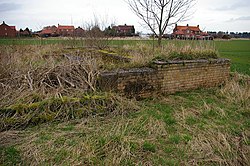Wildsworth
| Wildsworth | |
| Lincolnshire | |
|---|---|
 Ruins of St John's Church, Wildsworth | |
| Location | |
| Grid reference: | SK808979 |
| Location: | 53°28’20"N, -0°47’2"W |
| Data | |
| Post town: | Gainsborough |
| Postcode: | DN21 |
| Local Government | |
| Council: | West Lindsey |
| Parliamentary constituency: |
Gainsborough |
Wildsworth is a village in Lindsey, the northern part of Lincolnshire. It is situated on the eastern bank of the River Trent, and approximately five miles north of Gainsborough and a mile upstream of East Ferry.
History
Wildsworth does not appear in the Domesday Book of 1086, although an earlier settlement is indicated by finds of 2nd- to 4th-century Roman pottery and building material.[1][2]<re>National Monuments Record: No. 349569 – Wildsworth</ref> Later evidence of settlement at Wildsworth is in late 12th-century documentation – an early 14th-century chapel is recorded as founded, although no ground evidence for this and the mediæval settlement have been found. It was only in the 19th century that Wildsworth size and population, through censuses, was indicated.[3] Previously observed cropmarks in the area show evidence of channels and banks associated with post-mediæval warping, which is to say controlled flooding of land to increase fertility.[4]
In 1870-72 Wildsworth was described as being a hamlet within the parish of Laughton, with a population of 150 in 27 houses.[5]
In 1885 Kelly's Directory reported Wildsworth again as a hamlet in the parish of Laughton, and with a population of 130. A chapel of ease to St John, built in 1838, was described as of white brick in Norman style, comprising a chancel and nave, and polygonal tower with one bell. The late Lady William Gordon, Lady of the Manor, had provided for the chapel building at a cost of £450. Wildsworth contained two Wesleyan chapels: Primitive and Methodist. A mixed school at Wildsworth was built in 1875 at a cost of £200 provided by the Hon. Mrs Meynell-Ingram, Lady of the Manor of Laughton. The school had provision for 80 children and had an average attendance of 35. Wildsworth occupations consisted of 10 farmers.[6]
St John's church was restored in 1896, and again in 1908 at a cost of £1,000 provided by Hon. Frederick George Lindley Meynell. Population in 1921 was 111. By 1933 Wildsworth was a township with an area of 1,039 acre, some of which worked by five farmers each with land over 150 acres.[7]
The previous parish church of St John was demolished before 2000. It was a Grade II listed building.[8] The church was built in 1838 to a design by Charles Biggs. It was of yellow brick and ashlar construction, and comprised a chancel, nave, vestry with boiler house (added in 1908), west doorway, and a polygonal embattled tower surmounted by a short spire. The nave contained pilasters topped by pinnacles which divided the walls into three bays, and the chancel a 1916 stained glass east window by Charles Eamer Kempe.[9][10][11]
Outside links
| ("Wikimedia Commons" has material about Wildsworth) |
- Information on Laughton from GENUKI (includes Wildsworth}
- St John's Church, Wildsworth, Wparkinson.com
References
- ↑ National Monuments Record: No. 325030 – Wildsworth
- ↑ National Monuments Record: No. 891760 – Wildsworth
- ↑ National Monuments Record: No. 891759 – Wildsworth
- ↑ National Monuments Record: No. 1057070 – Wildsworth
- ↑ Wildsworth, Lincolnshire on Vision of Britain. Quoting John Marius Wilson's Imperial Gazetteer of England and Wales
- ↑ Kelly's Directory of Lincolnshire with the port of Hull 1885, p. 512
- ↑ Kelly's Directory of Lincolnshire 1933, p. 337
- ↑ 'St John's Church (site of), Wildsworth'
- ↑ National Heritage List 1165941: Church of St John the Divine (Grade II listing)
- ↑ Nikolaus Pevsner: The Buildings of England: Lincolnshire, 1964; 1989 Penguin Books ISBN 978-0-300-09620-0page 422
- ↑ National Monuments Record: No. 527293 – St John the Divine Church
